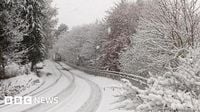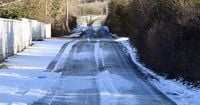Britain is facing its first significant cold snap of the season, as the Met Office issues a series of yellow and amber weather warnings for snow and ice across large swathes of the UK from November 18 to 20, 2025. From the rugged Highlands of Scotland to the rolling hills of Cornwall, communities are being urged to brace for hazardous travel, power outages, and a sudden plunge in temperatures that marks a dramatic shift from the unusually mild weather earlier this month.
According to BBC, the South West of England—including most of Cornwall and parts of north and west Devon—has been placed under a yellow warning for snow and ice from midday on Wednesday, November 19, until midnight on Thursday, November 20. The forecast predicts wintry showers and temperatures dropping to freezing (0°C, 32°F), with snow accumulations of 2cm to 5cm (0.8in to 2in) possible in some areas. Isolated spots could see as much as 10cm (4in) of snow, especially further inland and overnight. The Met Office has advised drivers to “amend travel plans if necessary,” warning that icy roads could make for treacherous conditions and that there is a slight chance of bus and train delays or cancellations, as well as potential power cuts.
But the South West is hardly alone. As reported by BBC and The Independent, yellow weather warnings are also in effect for Scotland, northern England, Northern Ireland, Wales, the Midlands, and several coastal areas of England. The timing of these warnings varies: some are in place until 11:00 on Wednesday, November 19, while others extend to 21:00 on Thursday, November 20. The Met Office expects snow accumulations of 2-5cm (0.8-2in) at lower elevations, with up to 10cm (4in) or more on higher ground. Northern Scotland, in particular, may experience frequent snow showers and significant accumulations.
Travel disruption is a recurring theme in the warnings. In Scotland, Bear Scotland—the agency responsible for trunk roads—has reported “snowy conditions” along major routes such as the A82 and A9, with snow ploughs deployed to keep roads clear. Some Calmac ferry services along the west coast and the Western Isles have faced delays or cancellations due to adverse weather. ScotRail has urged passengers to check the status of their journeys before setting out, and Stagecoach has promised to update customers about service changes via its app and social media channels. Gritters have been out pre-treating and patrolling roads, and authorities are advising travelers to remain vigilant and flexible. As the Met Office put it, “There is a chance of power cuts as well as road closures.”
The UK Health Security Agency (UKHSA) has issued amber and yellow cold health alerts for northern England and the Midlands, valid until Saturday, November 22. These alerts reflect not just the risk of travel disruption but also the potential impact of cold weather on vulnerable populations. Kirsty McCabe of the Royal Meteorological Society told BBC Radio’s Good Morning Scotland, “This is the first proper cold snap of the season. It’s really feeling quite wintry. Also, because we’ve got the snow and ice warnings out. Yes, most of the snow will be above higher ground, across parts of northern Scotland, but this evening could be quite a wintry mix coming down, even into the central belt to lower levels. So we could see a few flakes of snow this evening.”
For those planning to attend the Scotland versus Denmark World Cup qualifier at Hampden, Ms. McCabe cautioned that conditions could be “a bit sleety in places and maybe the odd rumble of thunder.” While the snow might not settle at lower levels, she warned it could still “make the roads more skiddy in places and could affect travel and the trains.” She added that the cold snap would persist until the end of the week, with temperatures possibly dropping to -10°C by Friday morning. However, a slight reprieve is expected over the weekend, as temperatures are forecast to return to seasonal averages.
The Independent highlighted that the Met Office has also issued an amber weather warning for snow in parts of Yorkshire on Thursday, November 20, from 5am to 9pm. This rare alert signals the likelihood of “substantial disruption,” with accumulations of 15-25cm expected on hills above 100m elevation. The Met Office’s chief forecaster, Neil Armstrong, explained, “Cold Arctic air from the north is firmly in charge of the UK’s weather, bringing the first notable cold snap of this autumn and giving an early taste of winter weather. As a result, winter hazards are likely through the next few days, with snow and ice a particular hazard, and the coldest conditions likely on Wednesday and Thursday.”
Armstrong continued, “Wintry showers will affect areas exposed to the brisk northerly wind, in particular Northern Ireland, south-west Wales, south-west England, north-east England and across the northern half of Scotland. Whilst not all places will see lying snow, where showers are most frequent accumulations of 2-5cm will be possible. On higher ground in Scotland 15-20cm could accumulate and potentially as much as 15-25cm over the North York Moors and Yorkshire Wolds.” He also warned that “temperatures are well below average for the time of year and could get as low as -11°C in rural parts of Scotland on Thursday night, with daytime temperatures generally in low single figures for many. With clear skies, overnight ice could create some particularly tricky travel conditions.”
National Highways has responded by mobilizing more than 530 gritters nationwide, with additional reserves on standby. Darren Clark, severe weather resilience adviser at National Highways, told The Independent, “We have more than 530 gritters available nationally and we can rapidly call on additional reserves when snow hits or conditions demand it. We work closely with the Met Office, receiving updated forecasts throughout the day and our crews are on duty around the clock, ready to head out whenever they’re needed. We’re also urging drivers to prepare for winter, and not be caught out by it. Quick checks, such as topping up fuel and screenwash, checking lights and tyres, and planning ahead, can make all the difference when the weather turns.”
Meanwhile, police and transport authorities across the UK are echoing calls for caution. Police Scotland has advised drivers to ensure their vehicles are roadworthy before setting out, while Scottish transport operators have outlined their winter resilience plans, including stocking up on 497,000 tonnes of salt—more than was used last winter—and prepping 240 gritters for snow ploughing and salt spreading on trunk roads. Despite the sudden change, it’s worth noting that November has been remarkably mild up to this point, with overnight temperatures rarely dipping into single figures. Just last year, some parts of northern Scotland recorded temperatures below -10°C, including Braemar in Aberdeenshire, which hit a frigid -11.2°C.
As the country braces for more snow, ice, and freezing winds through Thursday night, the message from forecasters and authorities is clear: stay alert, plan ahead, and be prepared for a wintry week that could see a few surprises before milder conditions return by the weekend.






